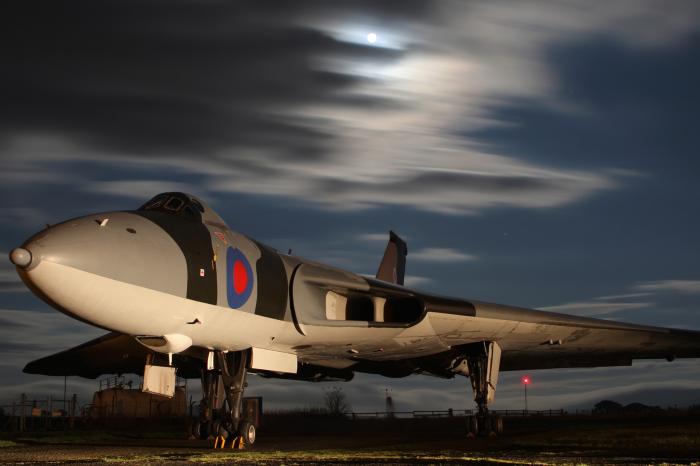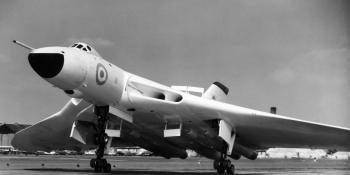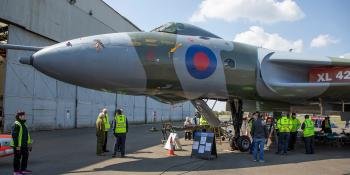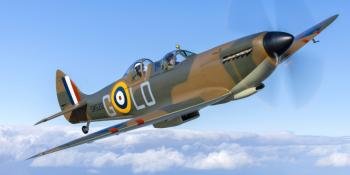FlyPast's Jamie Ewan provides a rundown of the complete Vulcans surviving worldwide
On par with the likes of other indomitable British types such as Supermarine’s elliptical masterpiece, the Spitfire and English Electric’s pugnacious Lightning, the Avro Vulcan holds a special place in the hearts and minds of those who knew and admired them just as strongly today as they did when they were defenders of the realm. The sheer number of Vulcans – especially when compared to its V-Force stablemates, the Handley Page Victor and Vickers Valiant – that have escaped the scrap man’s axe and are now housed in museums and private collections is evidence of this. While the number of complete Victors and Valiants staving off extinction added together is just five, no fewer than 19 of the 134 Vulcans built survive worldwide. Most of these jets remain ‘live’ in some form, be it electrically or hydraulically, and three remain capable of taxiing – quite a considerable feat considering the type’s complexities and size, and that it was withdrawn from service at a time when entire aircraft production runs were ultimately reduced to scrap…

XH558
Vulcan to the Sky Trust, Doncaster Sheffield Airport, South Yorkshire
The 12th B.2 built by Avro at Woodford Aerodrome under Contract 6/Air/11301/CB.6(a) for 17 aircraft signed September 30, 1954.
First flight – May 25, 1960. Completed – June 30, 1960. Delivered to 230 Operational Conversion Unit (OCU), RAF Waddington – July 8, 1960. To Hawker Siddeley Aviation (HSA) for modifications (mods) – February 11, 1964. Assigned to 230 OCU, RAF Finningley – February 2, 1965. Assigned to Waddington Wing (40, 50, 101 Sqns) – February 26, 1968. To HSA for conversion to B.2 SR2 (Maritime Radar Reconnaissance [MMR]) standard. Delivered to 27 Sqn, RAF Scampton – September 18, 1974. Assigned to 230 OCU, Scampton – October 18, 1976. Assigned to 27 Sqn, Scampton – November 29, 1976. Allocated to Waddington Wing (9, 44, 50, 101 Sqns) – March 31, 1982. To British Aerospace at Woodford for conversion to K.2 (tanker) – July 5, 1982. Delivered to 50 Sqn, Waddington – October 12, 1982. Attached to Ministry of Defence (Procurement Executive) at Aeroplane and Armament Experimental Establishment (A&AEE) Boscombe Down – October 25, 1982. Delivered to 50 Sqn, Waddington – November 30, 1982. Assigned to Waddington Station Flight for Vulcan Display Flight (reverted to B.2 configuration) – April 1, 1984. Assigned to Vulcan Display Flight – November 14, 1984. Last display flight – September 20, 1992. Struck off Charge and delivered to David Walton, Bruntingthorpe – March 23, 1993. Registered G-VLCN – February 6, 1995. Return to flight project begins – 1999. Registered to Vulcan to the Sky Trust – April 7, 2005. First post restoration flight – October 18, 2007. Final flight – October 28, 2015. Cancelled from UK Register – August 19, 2017.
Of note: Perhaps the most famous Vulcan, XH558 landed for the final time at Doncaster Sheffield Airport (DSA) in South Yorkshire on October 28, 2015. Having amassed 346 hours across some 228 flights under the Vulcan to the Sky Trust during her celebrated ‘second coming’, ‘558 captured the hearts and minds of many across the country and throughout the world. Today, the jet remains at DSA, however, it is likely XH558 will soon fall silent for the final time with plans to relocate the airframe by June 2023 following the closure of what was once Finningley – just one of the type’s spiritual homes.

XL318
Royal Air Force Museum, Hendon, North London
The 27th B.2 built by Avro at Woodford Aerodrome under Contract 6/Air/13145/CB.6(a) for 24 aircraft signed February 25, 1956.
First flight – August 11, 1961. Completed – August 30, 1961. Delivered to 617 Sqn, Scampton – September 4, 1961. To HSA at Woodford for Blue Steel mods retrofit – April 2, 1964. Delivered to Scampton Wing (27, 83, 617 Sqns) – April 21, 1965. Assigned to 617 Sqn, Scampton – November 19, 1969. Assigned to 230 OCU – May 22, 1972. To HSA at Bitteswell for mods – October 18, 1972. Delivered to 230 OCU, Scampton – March 4, 1973. Assigned to 617 Sqn, Scampton – March 5, 1974. Assigned to Waddington Wing (9, 44, 50, 101 Sqns) – June 18, 1975. Assigned to 230 OCU, Scampton – August 5, 1975. Assigned to 617 Sqn, Scampton – July 1, 1981. Final flight – December 11, 1981 (marked the end of 617 Vulcan operations). Declared non-effective Cat.5 (display) and allocated maintenance serial 8733M – December 17, 1981. Allocated for preservation within the RAF Museum’s collection – January 4, 1982.
Of note: Formerly allocated to the RAF Museum on January 4, 1982, XL318 was defueled, drained, vented and dismantled by a team from Aircraft Salvage and Transport Flight at RAF Abingdon in Oxfordshire. Going on to be delivered in sections by road to the collection’s Hendon site in northwest London the following month, ‘318 was rebuilt and placed on display in the museum’s Bomber Command Hall on June 18, that same year. This makes XL318 the only example of the type to have been dismantled, moved by road, and reassembled.
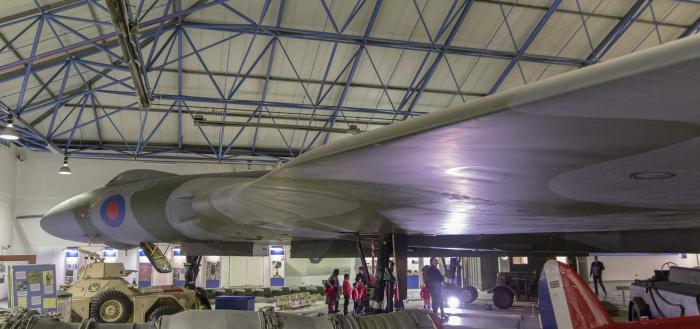
XL319
North East Land Sea & Air Museum, Sunderland Airport, Tyne & Wear
The 28th B.2 built by Avro at Woodford Aerodrome under Contract 6/Air/13145/CB.6(a) for 24 aircraft signed February 25, 1956.
First flight – October 1, 1961. Completed – October 19, 1961. Delivered to 617 Sqn, Scampton – October 23, 1961. Assigned to Scampton Wing (27, 83, 617 Sqns) – April 28, 1964. To HSA at Woodford for Blue Steel retrofit – May 5, 1964. Delivered to Scampton Wing (27, 83, 617 Sqns) – July 22, 1965. Assigned to Scampton Wing (27, 617 Sqns) – April 30, 1970. Assigned to 230 OCU, Scampton – May 14, 1970. Assigned to 617 Sqn, Scampton – May 22, 1971. To HAS at Woodford for mods – May 8, 1972. Delivered to 230 OCU, Scampton – September 21, 1972. Assigned to 35 Sqn, Scampton – October 16, 1978. To HSA at Bitteswell for mods – May 8, 1979. Delivered to 35 Sqn, Scampton – March 25, 1980. Assigned to Waddington Wing (9, 44, 50, 101 Sqns) – March 1, 1982. Allocated to the North East Land Sea & Air Museum for preservation – January 20, 1983. Last flight (ferried to Sunderland Airport) – January 21, 1983.
Of note: Acquired by the North East Land Sea & Air Museum for £5,000 (more than £20,855 today!) the jet – the first of its kind to be released to an independent collection in the UK – was flown to Sunderland Airport by Sqn Ldr John Reeve and Sqn Ldr Neil McDougall DFC on January 21, 1983. With a wingspan of 111ft and a length of 101ft, XL319 was the biggest aircraft to land at the now closed airport.

XL361
Happy Valley - Goose Bay, Canada
The 33rd B.2 built by Avro at Woodford Aerodrome under Contract 6/Air/13145/CB.6(a) for 24 aircraft signed February 25, 1956.
First flight – February 21, 1962. Completed – March 14, 1962. Delivered to 617 Sqn, Scampton – March 15, 1962. To HSA at Woodford (Blue Steel missile separation tests) – July 3, 1963. To Scampton – July 15, 1963. To HSA at Woodford (Blue Steel low-level system test) – August 19, 1963. To Scampton Wing (27, 83, 617 Sqns) – April 1, 1964. To HSA at Woodford for Blue Steel retrofit – March 25, 1965. Delivered to Scampton Wing (27, 83, 617 Sqns) – January 28, 1966. Assigned to Scampton Wing (27, 617 Sqns) – December 9, 1969. Assigned to 230 OCU, Scampton – October 7, 1970. Assigned to 617 Sqn, Scampton – April 5, 1971. Assigned to 230 OCU, Scampton – May 12, 1971. To HSA for mods – August 13, 1971. Delivered to 230 OCU, Scampton – December 31, 1971. Assigned to A&AEE at Boscombe Down (Simulated Radar Image Modelling (SRIM), 3898 trials) – December 12, 1974. To 230 OCU, Scampton – January 10, 1975. Assigned to 617 Sqn, Scampton – January 14, 1975. To A&AEE at Boscombe Down (Static error pressure check) – August 6, 1975. Returned to 617 Sqn, Scampton – September 2, 1975. Assigned to 35 Sqn, Scampton – August 3, 1977. To HSA at Bitteswell – September 5, 1978. Delivered to Waddington Wing (9, 44, 50, 101 Sqns) – June 13, 1981. Diverted to Canadian Forces Base Goose Bay Goose Bay, Newfoundland following fire – November 13, 1981. Struck off Charge – December 12, 1981.
Of note: On November 13, 1981, XL361 – in the hands of a crew from 9 Sqn – suffered a fire while on route to Offutt Air Force Base in Nebraska, US, resulting in an emergency landing at Goose Bay. However, with the Vulcan fleet entering the twilight of its service and airframes already heading to the scrapman, the decision was taken to ground the stricken jet. Struck off Charge on December 12 that year, ‘361 was slated to become the gate guardian for the RAF Support Unit based at Goose. Subsequently on June 14, 1982, at the request of the mayor of the nearby community of Happy Valley, XL361 was gifted to the town where it remains on display today.
XL426
Vulcan Restoration Trust, Southend Airport, Essex
The 44th B.2 built by Avro at Woodford Aerodrome under Contract 6/Air/13145/CB.6(a) for 24 aircraft signed February 25, 1956 – see https://www.key.aero/article/how-do-you-keep-avro-vulcan-howling
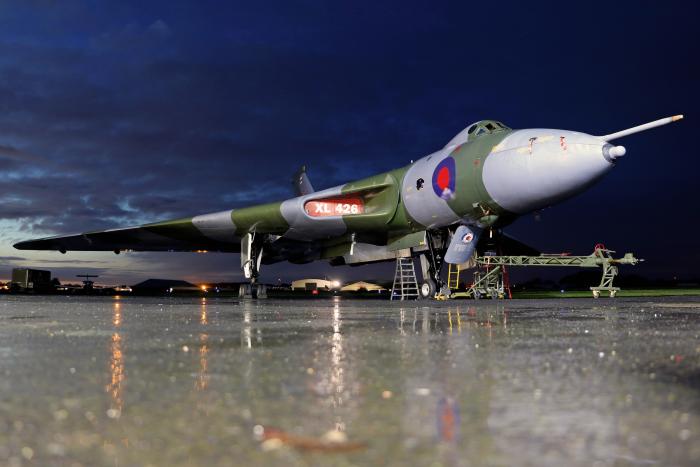
XM573
Strategic Air Command & Aerospace Museum, Ashland, Nebraska, USA
The 54th B.2 built by Avro at Woodford Aerodrome under Contract KB/B/01/CB.6(a) for 40 aircraft signedJanuary 22, 1958.
First flight – February 2, 1963. Completed – March 26, 1963. Delivered to 83 Sqn, Scampton – March 28, 1963. To HSA at Woodford for Blue Steel retrofit – March 14, 1966. Delivered to Waddington Wing (44, 50, 101 Sqns) – April 26, 1967. Assigned to 230 OCU, Finningley – February 19, 1968. Assigned to Akrotiri Wing, Cyprus, (9, 35 Sqns) – June 26, 1970. Assigned to 27 Sqn, Scampton – April 18, 1974. Assigned to Waddington Wing (9, 44, 50, 101 Sqns) – March 9, 1977. To RAF St Athan, South Wales (Major Inspection (MI)) – June 20, 1978. Delivered to Waddington Wing (44, 50, 101 Sqns) – September 7, 1978. Assigned to 230 OCU, Scampton – December 18, 1978. Assigned to Waddington Wing (44, 50, 101 Sqns) – April 7, 1981. Withdrawn from use (WFU) – May 22, 1981. Last flight (delivered to Offutt AFB, Nebraska) – June 7, 1982.
Of note: Allocated to what was then the Strategic Air & Space Museum (now the Strategic Air Command & Aerospace Museum) as a token of the links between the RAF and US Strategic Air Command. Presented to the USAF on June 13, 1982, the jet was later moved to the collection’s new home at Ashland in 1997. Having spent most of her retirement exposed to the harsh weather conditions typical of Nebraska – summer highs of around 30-35°C and winter temperatures often well below -10°C – the airframe has recently been moved indoors to undergo a complete restoration.

XM594
Newark Air Museum, Newark, Nottinghamshire
The 58th B.2 built by Avro at Woodford Aerodrome under Contract KB/B/01/CB.6(a) for 40 aircraft signed January 22, 1958.
First flight – March 28, 1963. Completed – July 9, 1963. Delivered to 27 Sqn, Scampton – July 19, 1963. To HSA at Woodford for mods – December 30, 1965. Delivered to Scampton Wing (27, 83, 617 Sqns) – May 16, 1966. Assigned to Scampton Wing (27, 617 Sqns) – July 7, 1970. To HSA at Woodford for mods – March 29, 1972. Delivered to Waddington Wing (44, 50, 101 Sqns) – August 24, 1972. Assigned to Waddington Wing (9, 44, 50, 101 Sqns) – January 19, 1973. To HSA at Bitteswell for mods – July 7, 1976. Delivered to Waddington Wing (9, 44, 50, 101 Sqns) – March 31, 1977. To St Athan (MI) – January 24, 1978. Delivered to Waddington Wing (9, 44, 50, 101 Sqns) – May 26, 1978. Sold for preservation (Newark Air Museum) – January 19, 1983. Last flight (delivered to former RAF Winthorpe) – February 7, 1983.
Of note: One of eight examples originally slated for preservation in the UK, XM594 was acquired by Stuart Stephenson for £5,000 (the equivalent of more than £20,000 today) and delivered to the former RAF Winthorpe (just to the northeast of Newark in Nottinghamshire) home to then-nascent Newark Air Museum (NAM) – at the time XM594 was the only RAF Vulcan to be flown into a non-licensed airfield for disposal. In early 2004, the jet was sold to the Lincolnshire Lancaster Association and loaned back to the NAM. Since then, ownership of XM594 – which has just emerged from a major refurbishment project – has been transferred to NAM.
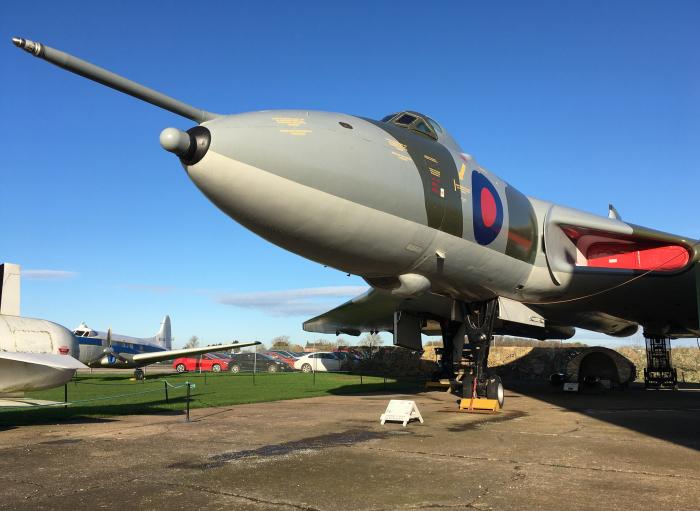
XM597
National Museum of Flight, East Fortune Airfield, Lothian, Scotland
The 61st B.2 built by Avro at Woodford Aerodrome under Contract KB/B/01/CB.6(a) for 40 aircraft signed January 22, 1958.
First Flight – July 12, 1963. Completed – August 26, 1963. Delivered to 12 Sqn, RAF Coningsby – August 28, 1963. To HSA at Woodford for mods – September 4, 1964. Delivered to Coningsby Wing (9, 12, 35 Sqn) – December 21, 1964. Assigned to Waddington Wing (44, 50, 101 Sqns) – April 18, 1967. To HSA at Woodford (ARI 18228/1 radar warning receiver [RWR] temporarily installed) – November 29, 1971. To A&AEE (RWR trials) – October 4, 1972. Assigned to Waddington Wing (44, 50, 101 Sqns) – February 12, 1973. To HSA at Bitteswell for mods – June 8, 1978. Delivered to Waddington Wing (9, 44, 50, 101 Sqns) – March 6, 1979. To St Athan (MI) – July 30, 1979. Delivered to Waddington Wing (9, 44, 50, 101 Sqns) – November 5, 1979. Modified for ‘Black Buck’ operations – 1982. Assigned to 50 Sqn – December 24, 1982. Last flight (delivered to East Fortune, Scotland) – April 12, 1984.
Of note: One of only two Vulcans to employ weapons in anger, XM597 was one of six airframes selected for conversion back to the type’s often forgotten conventional bombing role in light of the Argentine invasion of the Falkland Islands in April 1982. Going on to fly two anti-radar missions against Argentine positions from the Ascension Islands in the South Atlantic during ‘Black Buck 5’ on May 31, 1982, and ‘Black Buck 6’ three days later, XM597 was credited with the destruction of a Swiss-built Skyguard radar system using an AGM-45 Shrike. During the latter mission that ‘597 was forced to divert to Rio de Janeiro in Brazil after its refuelling probe was damaged during refuelling.
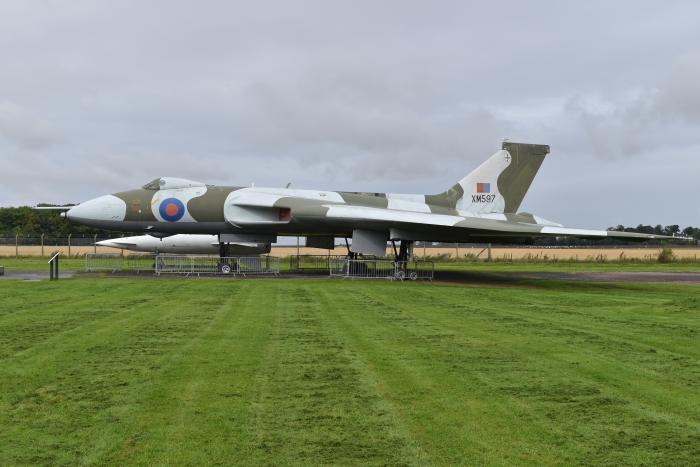
XM598
RAF Museum Midlands, RAF Cosford, Shropshire
The 62nd B.2 built by Avro at Woodford Aerodrome under Contract KB/B/01/CB.6(a) for 40 aircraft signed January 22, 1958.
First flight – August 8, 1963. Completed August 30, 1963. Delivered to 12 Sqn – September 4, 1962. To HAS at Woodford for mods – December 1, 1964. Delivered to RAF Cottesmore Wing (9, 12, 35 Sqns) – January 1, 1965. To HAS at Woodford for mods – January 31, 1966. Delivered to Cottesmore Wing (9, 12, 35 Sqns) – March 2, 1966. To HAS at Woodford for mods – December 29, 1966. Delivered to Cottesmore Wing (9, 12, 35 Sqns) – March 13, 1967. Assigned to Waddington Wing (44, 50, 101 Sqns) – April 9, 1968. To HAS at Woodford for mods – May 20, 1971. Delivered to Waddington Wing – October 13, 1971. To HAS at Woodford for mods – September 28, 1975. Delivered to Waddington Wing (9, 44, 50, 101 Sqns) – July 9, 1976. To St Athan (MI) – November 23, 1977. Delivered to Waddington Wing (9, 44, 50, 101 Sqns) – February 26, 1979. Modified for ‘Black Buck’ Operations – 1982. WFU – December 21, 1982. Assigned to No.2 School of Technical Training at RAF Cosford as 8778M – January 18, 1983. Last flight – January 20, 1983.
Of note: One of the five jets chosen for conversion back to the conventional bombing role in light of Argentina’s invasion of the Falkland Islands, XM598 was designated as the primary jet for ‘Black Buck 1’ on April 30-May 1 that year – however it was replaced by the reserve (see XM607) after a cabin pressurization issue forced the jet to return to Ascension shortly after take-off. Acting as the reserve jet for all of the subsequent ‘Black Buck’ missions, the airframe is now on display at the National Cold War Exhibition at Royal Air Force Museum Midlands.

XM603
Avro Heritage Museum, Woodford airfield, Cheshire – owned by Harrow Estates
The 67th B.2 built by Avro at Woodford Aerodrome under Contract KB/B/01/CB.6(a) for 40 aircraft signedJanuary 22, 1958.
First flight – November 15, 1963. Completed November 29, 1963. Delivered to 9 Sqn, Coningsby – December 4, 1963. To HAS at Woodford for mods – July 12, 1965. Delivered to Cottesmore Wing (9, 12, 35 Sqns) – October 6, 1965. Assigned to Waddington Wing (44, 50, 101 Sqns) – January 18, 1968. To HAS at Woodford for mods – August 19, 1974. Delivered to Waddington Wing (9, 44, 50, 101 Sqns) – June 5, 1975. To St Athan (MI) – August 15, 1977. Delivered to Waddington Wing (9, 44, 50, 101 Sqns) – November 3, 1977. To HAS at Bitteswell for mods – December 20, 1979. Delivered to Waddington Wing (9, 44, 50, 101 Sqns) – September 18, 1980. WFU – early 1982. Last flight (delivered to British Aerospace [currently BAE Systems] at Woodford for preservation) – March 12, 1982.
Of note: The only Vulcan in the world to be preserved in the type’s iconic anti-flash white scheme, the jet was given a new lease of life shortly after its delivery to Woodford when the decision was made to convert six aircraft into ‘stop-gap’ tankers – XM603 was instrumental in what was soon designated the Vulcan K.2, using this jet to ‘mock up’ the type’s tanker conversion. Later used to help sustain and support the UK’s other runners (XL426, XM655 and XH558), XM603 played a vital part in keeping G-VLCN airborne, with various tests being carried out on ‘her’ airframe to ascertain the jet’s useful life. Today the jet, which underwent a full restoration in 2016 to return it to how it was when it rolled out of the factory at Woodford more than 50 years before, is the centrepiece of the superb Avro Heritage Museum.
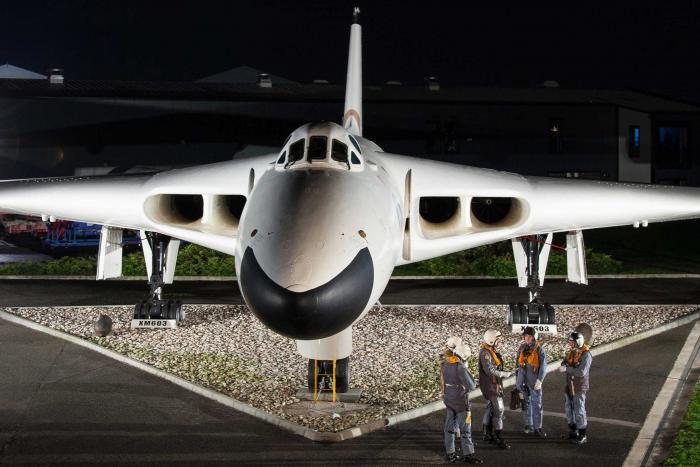
XM605
Castle Air Museum, Atwater, California, USA
The 69th B.2 built by Avro at Woodford Aerodrome under Contract KB/B/01/CB.6(a) for 40 aircraft signedJanuary 22, 1958.
First flight – November 11, 1963. Completed – December 12, 1963, XM605. Delivered to 9 Sqn, RAF Coningsby – February 1, 1963. To HAS at Woodford for mods – September 8, 1965. Delivered to Cottesmore Wing (9, 12, 35 Sqns) – December 14, 1965. Assigned to Waddington Wing (44, 50, 101 Sqns) – February 2, 1968. To HAS at Woodford for mods – August 2, 1971. Delivered to Waddington Wing (44, 50, 101 Sqns) – December 7, 1971. To HSA at Woodford for mods – December 23, 1975. Delivered to Waddington Wing (9, 44, 50, 101 Sqns) – September 30, 1976. To St Athan (MI) – November 30, 1979. Delivered (9, 44, 50, 101 Sqns) – February 2, 1980. Last operational sortie – August 20, 1981. Allocated to Castle AFB, California for preservation – September 2, 1981. Final flight (delivered to Castle AFB) – September 8, 1981.
Of note: At the time of its allocation to the museum, Castle Air Force Base was home to a collection housed under the USAF Museum system. Arriving at Castle AFB on September 8, 1981, the jet was officially handed over to the museum, which is now an independent collection, six days later, following demilitarization. The RAF returned the next year to retrieve the jet’s refueling probe while scrambling to prepare the Vulcan fleet for war in the South Atlantic but returned it soon after.
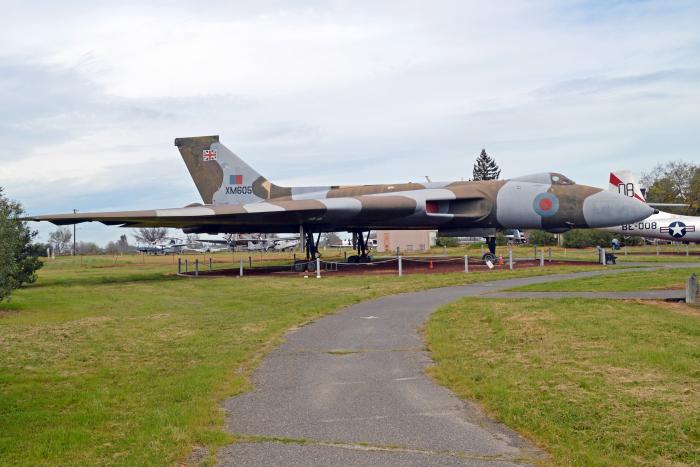
XM606
Barksdale Global Power Museum, Barksdale Air Force Base, Louisiana, USA
The 70th KB/B/01/CB.6(a) of 40 aircraft, contract signed January 22, 1958.
First flight – November 28, 1963. Completed – December 12, 1963. Delivered to 12 Sqn, Coningsby – December 30, 1960. To HSA at Woodford for mods – October 30, 1963. Delivered to Cottesmore Wing (9, 12, 35 Sqns) – February 18, 1965. To HSA at Woodford for mods (Installation of Terrain-Following Radar [TFR] and long-range fuel tank) – June 14, 1965. To Ministry of Aviation at A&AEE Boscombe Down (TFR and endurance trials) – February 2, 1966. To HSA at Woodford for mods – May 2, 1967. Delivered to Cottesmore Wing – April 4, 1968. Assigned to Waddington Wing (44, 50, 101 Sqns) – May 13, 1968. To HSA at Woodford for mods – April 13, 1972. Delivered to Waddington Wing (44, 50, 101 Sqns) – August 25, 1972. To HAS at Bitteswell for mods – October 6, 1977. Delivered to Waddington Wing (9, 44, 50, 101 Sqns) – July 27, 1978. WFU – May 6, 1982 (allocated to Barksdale AFB, Louisiana for preservation). Last flight (ferried to Barksdale AFB) June 7, 1982.
Of note: ‘X-Ray, Mike, Six, Oh, Six’ was gifted to the USAF as a token of the links between the RAF and Strategic Air Command and delivered to Barksdale to join the collection of what was then known as the 8th Air Force Museum. Today the aircraft, fittingly, sits next to two of her SAC counterparts – a Boeing B-52D and a B-52G – close to Barksdale’s old Alert Facility.
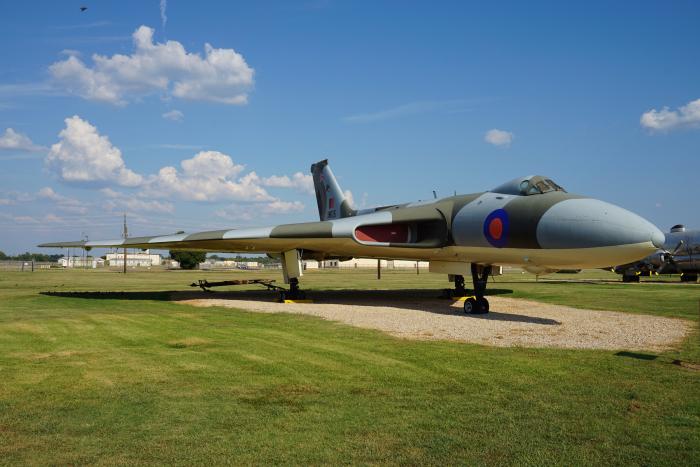
XM607
RAF Waddington, Lincolnshire
The 71st B.2 built by Avro at Woodford Aerodrome under Contract KB/B/01/CB.6(a) for 40 aircraft signed January 22, 1958.
First flight November 29, 1963. Completed – December 30, 1963. Delivered to 35 Sqn, Coningsby – January 1, 1964. To HSA at Woodford for mods – December 21, 1964. Delivered to Cottesmore Wing (9, 12, 35 Sqns) – March 30, 1965. Assigned to Cottesmore Wing (9, 35 Sqns) – March 22, 1968. Assigned to Waddington Wing (44, 50, 101 Sqns) – May 24, 1968. To HSA at Woodford for mods – December 21, 1970. Delivered to Waddington Wing (44, 50, 101 Sqns) – April 23, 1971. To HSA at Woodford for mods – June 17, 1974. Delivered to Waddington Wing (9, 44, 50, 101 Sqns) – March 23, 1975. To St Athan (MI) – January 31, 1979. Delivered to Waddington Wing (9, 44, 50, 101 Sqns) – April 18, 1979. To HSA at Bitteswell for mods – December 18, 1979. Delivered to Waddington Wing (9, 44, 50, 101 Sqns) – March 25, 1980. Modified for ‘Black Buck’ Operations – 1982. WFU – December 17, 1982. Assigned to Waddington as 8779M for preservation – January 19, 1983.
Of note: One of six airframes returned to its conventional bombing role in light of the Argentine invasion of the Falklands Islands in April 1982, ‘607 went on to become the first Vulcan to drop weapons in anger during the much-acclaimed mission against Port Stanley Airport on April 30/May 1 that year – ‘Black Buck 1’. Allocated as the primary jet for both ‘Black Buck 2’ and ‘Black Buck 7’ on May 3/4 and June 12, respectively, what is often regarded as the RAF’s most famous jet was undergoing a major restoration at its Waddington home at the time of writing in mid-November 2022.

XM612
City of Norwich Aviation Museum, Norfolk
The 76th B.2 built by Avro at Woodford Aerodrome under Contract KB/B/01/CB.6(a) for 40 aircraft signedJanuary 22, 1958.
First flight: February 13, 1964. Completed – February 28, 1964. Delivered to Cottesmore Wing (9, 12, 35 Sqns) – March 3, 1964. To HSA at Woodford for mods – September 1, 1965. Delivered to Cottesmore Wing (9, 12, 35 Sqns) – November 20, 1965. Assigned to Waddington Wing (44, 50, 101 Sqns) – January 29, 1968. To A&AEE (Airstream Direction Detector Comparator Unit trials) – March 5, 1968. Delivered to Waddington Wing (44, 50, 101 Sqns) – April 4, 1968. To HSA at Woodford for mods – March 8, 1972. Delivered to Waddington Wing (9, 44, 50, 101 Sqns) – July 21, 1972. To HSA at Bitteswell for mods – January 1, 1977. Delivered to Waddington Wing (9, 44, 50, 101 Sqns) – October 10, 1977. To St Athan (MI) – July 28, 1978. Delivered to Waddington Wing (9, 44, 50, 101 Sqns) – October 18, 1978. To HSA Repair Works at Bitteswell – August 15, 1980. Delivered to Waddington Wing (9, 44, 50, 101 Sqns) – May 7, 1981. Modified for ‘Black Buck’ operations – 1982. WFU – December 1982. Sold for preservation (City of Norwich Aviation Museum) – January 19, 1983. Last flight (delivered to Norwich Airport) – January 30, 1983.
Of note: One of the four airframes deployed to the Ascension Islands in the South Atlantic during the Vulcan’s sole combat campaign, XM612 was allocated as the reserve aircraft for the subsequently cancelled ‘Black Buck 3’ on May 13, 1982. On its withdrawal, the airframe was purchased by the City of Norwich Air Museum for the sum of £5,026 (the equivalent of more than £20,000 today). Today the jet – which is often open for tours – remains in a ‘semi-live’ state thanks for the near constant cycle of remedial and restoration work led by the museum’s volunteers.

XM655
XM655 Maintenance and Preservation Society, Wellesbourne Mountford Aerodrome, Warwickshire
The 87th B.2 built Avro at Woodford Aerodrome under Contract KB/B/01/CB.6(a) for 40 aircraft signedJanuary 22, 1958.
First flight – November 2, 1964. Completed – November 19, 1964. Delivered to Cottesmore Wing (9, 12, 35 Sqns) – November 23, 1964. To HSA at Woodford for mods – November 25, 1965. Delivered to Cottesmore Wing (9, 12, 35 Sqns) – February 9, 1966. To HSA at Woodford for mods – September 8, 1966. Delivered to Cottesmore Wing (9, 12, 35 Sqns) – February 27, 1967. Assigned to Waddington Wing (44, 50, 101 Sqns) – January 12, 1968. To HSA at Bitteswell for mods – July 2, 1973. Delivered to Waddington Wing (44, 50, 101 Sqns) – January 24, 1974. To HSA at Bitteswell for mods – June 23, 1978. Delivered to Waddington Wing (9, 44, 50, 101 Sqns) – March 23, 1979. To St Athan (MI) – April 7, 1979. Delivered to Waddington Wing (9, 44, 50, 101 Sqns) – July 12, 1979. WFU – 1983. Sold for preservation (to Roy Jacobsen) – February 11, 1984. Last flight (delivered to Wellesbourne Mountford Aerodrome, Warks) – February 11, 1984. Reregistered G-VULC – February 27, 1984 (cancelled on March 25, 2002). Registration N665AV reserved on US civil register (not taken up) – 1985.
Of note: The youngest of the surviving Vulcans, XM655 was originally bought by Roy Jacobsen with the intention of keeping ‘her’ flying on the airshow circuit under civilian rules. Underestimating the sheer complexity and finances needed to do just that, Jacobsen even considered moving XM655 to the US. Alas, the airframe was effectively left to rot, before it was eventually transferred to the airfield’s owner, John Littler, to pay for the accumulated parking fees. Slowly brought back to life, today, under the care of the XM655 Maintenance and Preservation Society, she frequently beats the quiet surroundings of Warwickshire into submission with her immense ‘howl’!

XJ824
Imperial War Museum (IWM), Duxford Airfield, Cambridgeshire
The 24th B.2 built Avro at Woodford Aerodrome under Contract 6/Air/l1 830/CB.6(a) for 8 aircraft signed March 31, 1955.
First flight – April 24, 1961. Completed – May 11, 1961. Delivered to 27 Sqn, Scampton – May 16, 1961. Assigned to 9 Sqn, Coningsby – February 25, 1963. Assigned to 230 OCU, Finningley – December 2, 1963. To HSA at Woodford for Blue Steel retrofit – May 28, 1965. Delivered to Cottesmore Wing (9, 12, 35 Sqns) – July 4, 1966. Assigned to Waddington Wing (44, 50, 101 Sqns) – October 4, 1966. Assigned to Cottesmore Wing (9, 35 Sqns) – June 19, 1968. Assigned to 35 Sqn, Scampton – January 1, 1975. To HSA at Woodford for mods – June 5, 1975. Delivered to 35 Sqn, Scampton – March 1, 1976. Assigned to Waddington Wing (9, 44, 50, 101 Sqns) – February 15, 1977. To HSA at Bitteswell for mods (last Vulcan to leave the site after manufacturer mods) – September 17, 1980. Delivered to Waddington Wing (9, 44, 50, 101 Sqns) – June 8, 1981. WFU – Early 1982. Last flight (delivered to Duxford Airfield) – March 13, 1982. Transferred to IWM for preservation – March 15, 1982.
Of note: Having flown around the world while serving at the forefront of Britain’s V-Force, XJ824 was saved for posterity by former Chairman of IWM Trustees, John Grandy – the only RAF officer who fought and commanded a squadron during the Battle of Britain to reach the post of Chief of the Air Staff. Landing at Duxford prior to the construction of the M11 motorway, the jet is located within the confines of the IWM Duxford’s immense AirSpace hangar. It has been suggested that the airframe – which currently boasts the colours of 101 Sqn – is scheduled for a major restoration in line with plans to rearrange what was originally dubbed the ‘super hangar’.
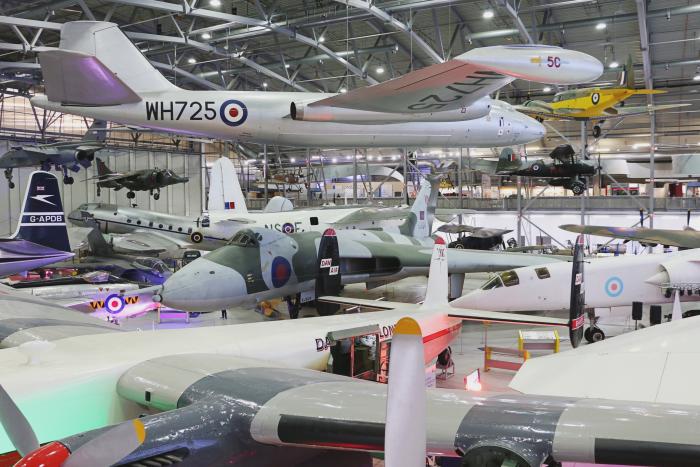
XL360
Midland Air Museum, Coventry Airport, Warwickshire
Thirty-second B.2 built by Avro at Woodford Aerodrome under Contract 6/Air/13145/CB.6(a) for 24 aircraft signed February 25, 1956.
First flight – January 31, 1962. Completed – February 28, 1962. Delivered to 617 Sqn, Scampton – March 2, 1962. To HSA at Woodford for Blue Steel mods retrofit – February 2, 1965. Delivered to Scampton Wing (27, 83, 617 Sqns) – October 27, 1965. Assigned to Scampton Wing (27, 617 Sqn) – September 24, 1970. To HSA at Woodford for mods – January 7, 1971. Delivered to Scampton Wing (27, 617 Sqn) – May 14, 1971. Assigned to 230 OCU, Scampton – July 31, 1971. Assigned to Waddington Wing (9, 44, 50, 101 Sqn) – August 15, 1975. Assigned to 230 OCU, Scampton – October 21, 1975. To HSA at Woodford for mods – February 24, 1977. Delivered to 617 Sqn, Scampton – December 12, 1977. Assigned to 35 Sqn, Scampton – May 31, 1978. Assigned to 101 Sqn, Waddington – January 5, 1982. WFU – early 1982. Sold for preservation (Midland Air Museum) – January 26, 1983. Last flight (delivered to Coventry Airport) – February 4, 1983
Of note: The largest aeroplane within the unique aeronautical collection that is the Midland Air Museum, XL360 was named ‘City of Coventry’ shortly after its arrival in 1983 in recognition of the namesake city – just to the north – and it’s effort in funding the airframe’s purchase. Although volunteers at the museum commenced a restoration programme in 2019, which was to include a full repaint, the still prominent COVID-19 pandemic resulted in work being delayed.
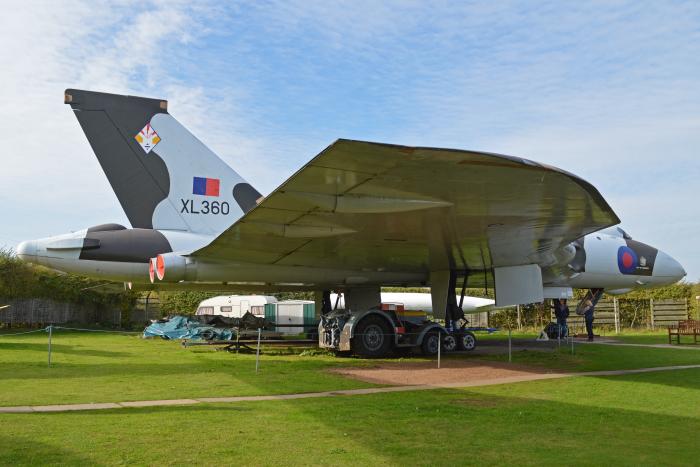
XM575
East Midlands Aeropark, Castle Donnington, Derbyshire
Fifty-sixth B.2 built Avro at Woodford Aerodrome under Contract KB/B/01/CB.6(a) for 40 aircraft signed January 22, 1958.
First Flight – April 19, 1963. Completed – May 21, 1963. Delivered to 617 Sqn, Scampton – May 25, 1963. To HAS at Woodford for mods – November 20, 1964. Delivered to Scampton Wing (27, 83, 617 Sqns) – March 22, 1965. Assigned to Waddington Wing (44, 50, 101 Sqns) – July 28, 1970. Assigned to Scampton Wing (27, 617 Sqns) – November 11, 1970. To HSA at Woodford for mods – December 22, 1972. Delivered to 617 Sqn, Scampton – June 28, 1973. Assigned to Waddington Wing (9, 44, 50, 101 Sqns) – March 15, 1974. To St Athan (MI) – October 9, 1980. Delivered to Waddington Wing (9, 44, 50, 101 Sqns) – January 5, 1981. WFU – early 1983. Sold for preservation (Loughborough and Leicestershire Air Museum and Preservation Society for display at East Midlands Airport [EMA]) – January 25, 1983. Last flight (delivered to EMA) – January 28, 1983
Of note: Following ‘her’ retirement, plans were soon afoot to transfer the jet to nearby Bruntingthorpe in Leicestershire with a one-off ferry trip and undertake a full return to flight project. With help from personnel from British Aerospace (today’s BAE Systems), the team went as far as reserving the registration G-BLMC on the UK Register in August 1984 and sought approval from the Civil Aviation Authority. Alas, the registration was never taken up as the team were soon faced with the biggest issue of all in aviation – finances! As such, the jet remained at EMA as part of the collection housed under what is now known as the East Midlands Aeropark.
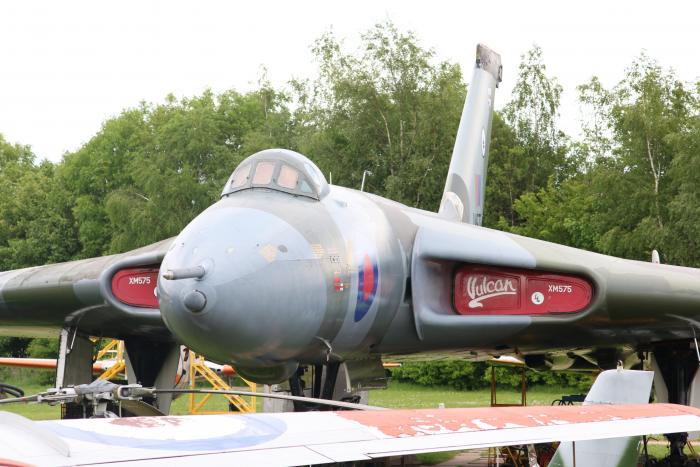
XJ823 – on loan, owned by Tom Stoddart
Solway Aviation Museum, Carlisle Airport, Cumbria
Twenty-third B.2 built Avro at Woodford Aerodrome under Contract 6/Air/l1 830/CB.6(a) for eight aircraft signed March 31, 1955.
First flight – March 30, 1961. Completed – April 20, 1961. Delivered to 27 Sqn, Scampton – April 24, 1961. Assigned to 35 Sqn, Scampton – January 8, 1963. Assigned to 230 OCU, Scampton – May 11, 1964. To HSA at Woodford for Blue Steel retrofit mods – June 28, 1965. Delivered to Waddington Wing (44, 50, 101 Sqns) – November 1, 1966. To HAS at Woodford for mods – February 19, 1968. Delivered to Cottesmore Wing (9, 35 Sqns) – April 30, 1968. Assigned to Waddington Wing (9, 44, 50, 101 Sqns – January 17, 1975. To HSA at Woodford for conversion to B.2 SR2 (MMR) standard – March 1977. Delivered to 27 Sqn, Scampton – April 27, 1977. Assigned to 35 Sqn, Scampton – April 2, 1981. Assigned to Waddington Wing (9, 44, 50, 101 Sqns) – May 1, 1982. WFU – 1982. Assigned to Waddington Holding Flight – January 4, 1983 . Sold for preservation (Tom Stoddard and David Hutchinson, Solway Aviation Society) – January 21, 1983. Last flight (delivered to Carlisle Airport) – January 24, 1983
Of note: On loan to the Solway Aviation Society at Carlisle Airport – home of the Solway Aviation Museum – XJ823 is the sole complete example of B.2(MRR) in existence. On display a short walk from the from the main museum site, like many Vulcans exposed to the elements, the jet has suffered at the hands of Mother Nature. That said, it has been reported there are plans afoot return the jet to a “semi-live” state (hydraulically and electrically at least) in the near future, with a full repaint also on the cards.
